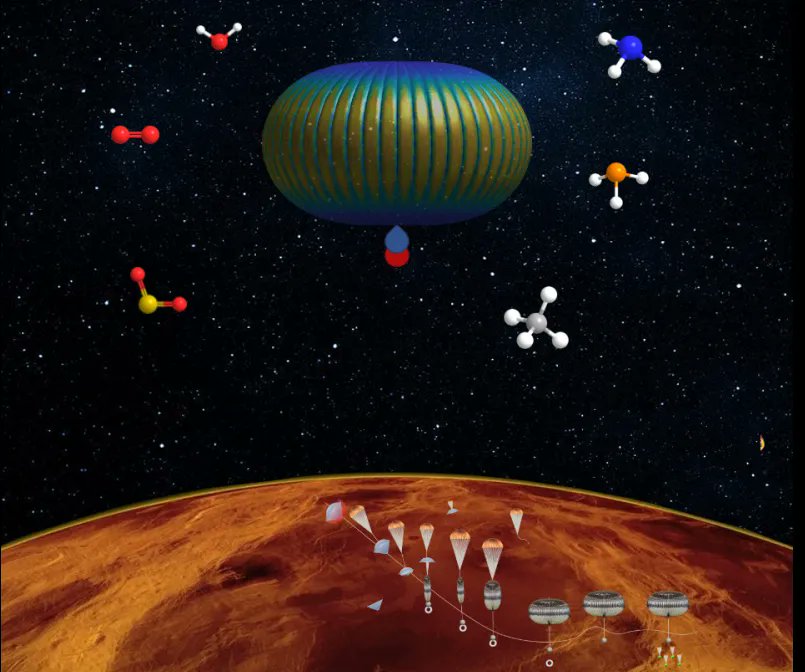Life on Venus, or the possibility thereof, has been a hot topic as of late. There’s also been plenty of controversies, including the (still disputed) discovery of phosphine, a potential biomarker in the atmosphere. The best way to lay that controversy to rest would be to go there and actually take samples, which at the very least, would help constrain the existence of life in Venus’ cloud layers.
And a wide-ranging team from academia and industry hopes to do just that. Originally announced late last year, the Venus Life Finder (VLF) mission concept focuses on what science would be needed to potentially discover life in the clouds of Venus. The team behind the mission certainly isn’t the first to come up with the idea of life in the Venusian clouds.
Despite his admonitions about dinosaurs on the Venusian surface, Carl Sagan and co-author Harold Morowitz were the first to scientifically publish the idea in 1967. Since then, we’ve sent several probes through the Venusian clouds, and they discovered plenty of strange chemistries that warrant another look. But unfortunately, we haven’t sent any probes back through the cloud layers since the 1980s.
Not only have technologies that might be useful in the search for life improved dramatically since then. So did the entire scientific field of Astrobiology, as noted in a new paper discussing future missions released by the VLF team. Remove All Ads on Universe Today Join our Patreon for as little as $3! Get the ad-free experience for life Those two facts in themselves should mean that it’s time for another look at Venus’ atmosphere from a biochemical perspective, and that’s what the VLF team is hoping to provide.
Their three-phase mission was originally defined late last year. And the first step is ambitious, to say the least. VLF’s team has contracted with Rocketlab to send a probe to the Venusian atmosphere using a 2023 launch window.
Rocketlab will provide the rocket and necessary transportation to our nearest neighbor. That would include a ride on the company’s Electron launch vehicle, Photon spacecraft, and an entry vehicle. Unfortunately, that entry vehicle will only allow a probe to collect data in the upper atmosphere of the clouds, where the climate is most hospitable, for approximately three minutes.
But those three minutes will be immensely valuable. The scientific payload for this first mission will focus on an Autoflourescing Nephelometer (AFN), which can make organic material shine, and would do so for any present organic material in Venus’ clouds. Previously probes already found some strangely shaped molecules that were not simply made of liquid sulfuric acid.
Known as Mode 3 particles, their existence is one of the main drivers behind the interest in the mission in the first place. An AFN, which is based on existing commercial technologies that are already used on the outside of airplanes, could provide unique insights that would inform the next mission – a balloon. The idea of a balloon mission to Venus isn’t new, either.
Some inspired futurists have even suggested that balloons might be able to support entire cities in Venus’ cloud layer. But the new VLF mission would not only utilize a balloon and gondola but would launch a series of probes down through the cloud layer that could potentially collect data on the environment further down. The scientific payload of this much more capable mission would include a spectrometer that would search for specific gases that might be key biosignatures, as well as a microelectricalmechanical system that can detect the presence of metals and an extremely sensitive pH sensor that could validate what the pH the balloon’s cloud layers would be.
Most of these technologies already exist, but some, such as a liquid concentrator to feed the spectrometer, still need to be developed. That development effort would feed nicely into the final of the three VLF missions – a sample return mission. Just like the planned sample return mission from Mars and the half a ton of rock brought back from the moon, the best way to truly understand what is going on chemically in a given part of the solar system is to bring a sample of it back to the labs on Earth.
The third VLF mission would design another balloon that would also include an ascending rocket that returns a sample of Venus’ atmosphere back to Earth to be directly studied by the best instruments we can muster. Without further technological advances to capture and effectively store the atmosphere, it would be a moot point, but experience from the other two missions would help inform the sample return mission. And there would still be plenty of time before any such mission is launched.
If the VLF team does manage to get its first mission off the ground next year, it would be an amazing accomplishment and could potentially lead to one of the most important discoveries science has ever made. Learn More: Seager et al – Venus Life Finder Missions Motivation and Summary UT – A Private Mission to Scan the Cloud Tops of Venus for Evidence of Life UT – Did Scientists Just Find Signs of Life on Venus? UT – High Altitude Life Can’t Explain the Trace Gases in Venus’ Atmosphere UT – Life Could Make Habitable Pockets in Venus’ Atmosphere ] Lead Image: Artist’s depiction of the balloon mission to Venus. Credit – Seager et al.
.

